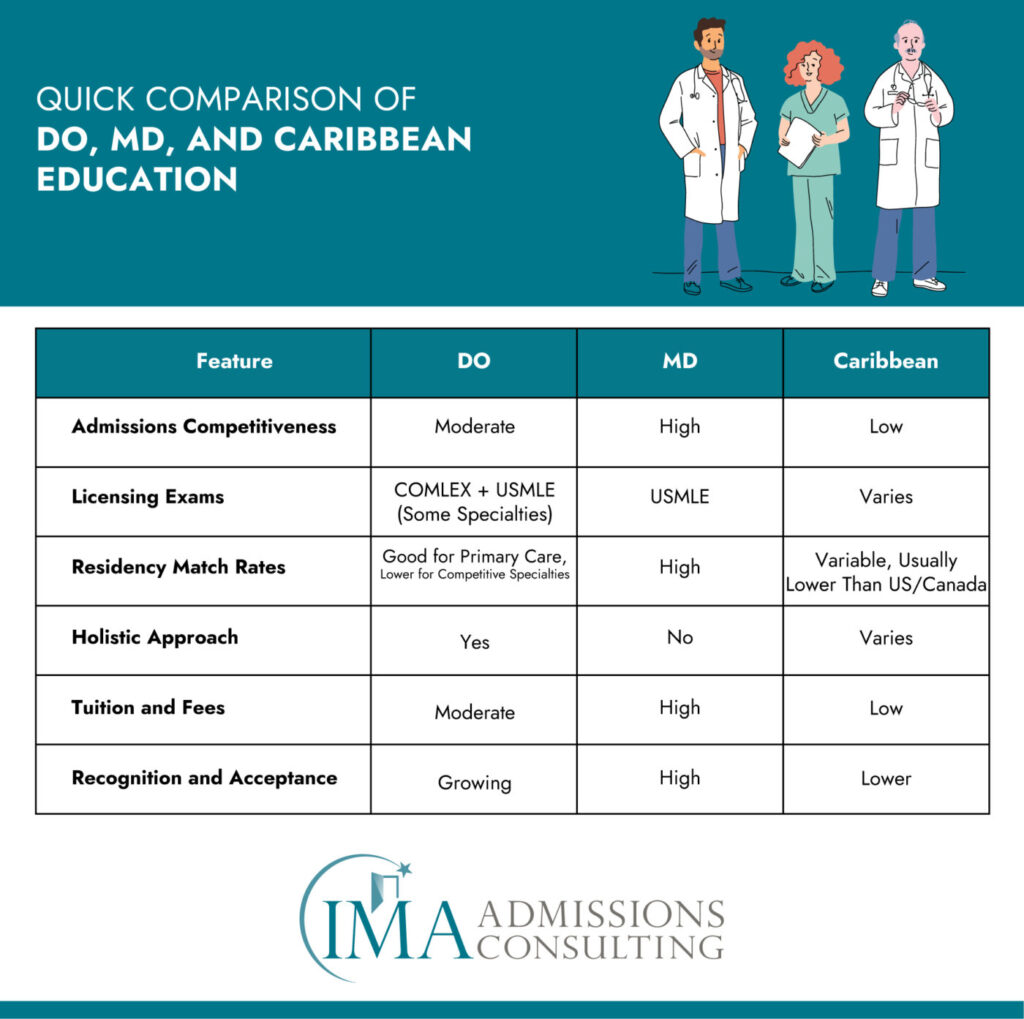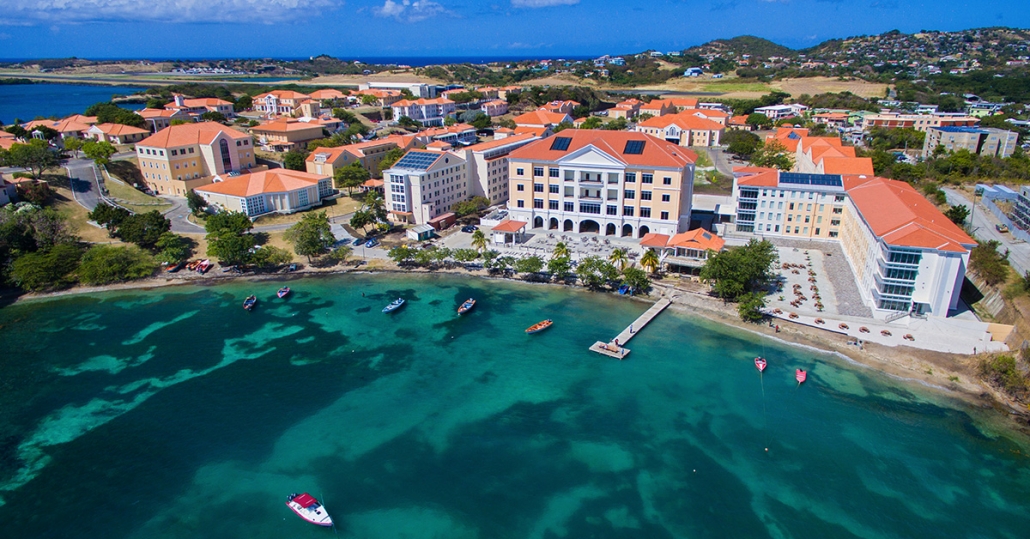If you’re considering a career in medicine in the U.S., you’ve likely come across the three primary paths to becoming a doctor: earning an MD (Doctor of Medicine) at a U.S. allopathic medical school, a DO (Doctor of Osteopathic Medicine) at an osteopathic medical school, or an MD at a Caribbean medical school. Each path has its unique set of pros and cons, and it’s crucial to navigate through the information (and misinformation) to make an informed decision that aligns with your career aspirations.
“DO” stands for Doctor of Osteopathic Medicine, a unique branch of medical practice emphasizing a holistic approach to patient care, focusing on the musculoskeletal system as a key to overall health. Osteopathic physicians (DOs) undergo similar training to MDs but with additional emphasis on osteopathic manipulative treatment (OMT), a hands-on approach to diagnosing and treating musculoskeletal conditions.
In terms of education, both DO and MD students typically undergo a four-year undergraduate program followed by four years in medical school. The curricula are comparable, with the notable addition in DO programs of training in OMT.
Post-graduation, both DO and MD graduates embark on residencies, which can range from three to seven years, across various specialties. The growth of osteopathic medicine, marked by a significant increase in DO students, reflects a growing awareness and acceptance of this medical approach, particularly under initiatives like Choose DO. This rise is reshaping the healthcare landscape, offering diverse approaches to patient care.
The choice between pursuing a DO or MD degree hinges on personal preference and career objectives. While some students are drawn to the holistic philosophy of osteopathic medicine, others prefer the traditional path of MD programs. Both DO and MD physicians are fully qualified to provide comprehensive medical care.
For more detailed information on the differences between MD and DO, their educational paths, and the unique aspects of osteopathic medicine, read What Does DO Mean After a Doctor’s Name?. Here, you’ll find extensive insights into osteopathic medicine, helping you make an informed decision about your healthcare education and career.
Three Medical School Paths
U.S. Allopathic Medical Schools (MD)
These institutions represent the most traditional route in medical education in the United States, awarding an MD (Doctor of Medicine) degree. Renowned for their rigorous academic environment, these schools attract a vast number of applicants each year, making admissions highly competitive.
Students who pursue an MD often benefit from a broad spectrum of training experiences, from basic sciences to a variety of clinical specialties. These schools are also recognized for their substantial contributions to medical research, offering students ample opportunities to engage in groundbreaking studies and innovation in healthcare.
One of the key strengths of U.S. allopathic medical schools is the diversity in specialization. Graduates have the flexibility to pursue numerous career paths, ranging from primary care to highly specialized fields. The extensive network and prestige associated with these institutions can also provide significant advantages in residency placements and future career opportunities.
Osteopathic Medical Schools (DO)
Osteopathic medical schools, awarding the DO (Doctor of Osteopathic Medicine) degree, offer a distinctive approach to medical education. These schools place a strong emphasis on a holistic view of medicine, prioritizing the treatment of the whole patient — mind, body, and spirit — rather than focusing solely on symptoms. DO programs are known for integrating osteopathic manipulative medicine (OMM) into their curriculum, a unique set of techniques used for diagnosis and treatment.
While admissions to DO programs are generally considered less competitive compared to MD schools, they still maintain rigorous academic standards. These programs offer comprehensive medical training that equips graduates with the skills necessary for a wide range of medical careers.
Graduates from DO programs can pursue the same specialties and have the same rights as MDs in practicing medicine. The philosophy of osteopathic medicine often attracts students interested in primary care, though graduates are by no means limited to this field.
Caribbean Medical Schools (MD)
Caribbean medical schools provide an alternative pathway to obtaining an MD degree, particularly for students who may not have secured admission into U.S. MD or DO schools. These institutions are often appealing due to their more lenient admission criteria and the allure of studying in a tropical environment. However, prospective students should be aware of certain challenges associated with these schools.
One significant concern is the lower residency match rates for graduates of Caribbean schools compared to their U.S. counterparts. This factor can have profound implications for a medical graduate’s career, as residency placements are crucial for medical licensure and practice. Additionally, Caribbean medical schools often have higher attrition rates, meaning a significant number of students may not complete their education.
Another factor to consider is the financial aspect. Caribbean medical schools can be expensive, and students may face limited access to federal financial aid. Furthermore, the educational experience and clinical training opportunities can vary widely among these schools.
While Caribbean medical schools offer a path to an MD degree, it is crucial for prospective students to thoroughly research and consider the potential challenges and implications for their future medical careers.
Prospective medical students should weigh these options carefully, considering their personal goals, learning preferences, and career aspirations. Each path offers unique advantages and challenges, and the decision should align with the individual’s aspirations, lifestyle, and commitment to the medical profession.
Here is a list of some of the more widely known Caribbean Schools:
Anguilla
Antigua and Barbuda
- American University of Antigua College of Medicine
- University of the West Indies, Cave Hill School of Medicine (Main Campus in Jamaica)
Aruba
Barbados
Belize
- Belize Medical School
- St. George’s University
Bonaire
Cayman Islands
Curaçao
Dominica
Grenada
Jamaica
Montserrat
Saba
St. Kitts and Nevis
St. Lucia
St. Maarten
St. Vincent and the Grenadines
Trinidad and Tobago
This list includes accredited schools recognized by the Caribbean Medical University Council (CMUC). Be sure to research each school individually for specific details like match rates, tuition fees, and program features.
The Data Tells a Story
Success Rates
MD schools in the U.S. have high match rates for residencies and lower dropout rates, making them a reliable choice for medical education. DO schools also have strong match rates, albeit slightly lower than their MD counterparts. Caribbean schools, however, lag significantly behind in both these areas.
Academic Requirements
Statistically, MD programs demand higher GPA and MCAT scores than DO programs. Caribbean schools often have lower entry requirements but come with their own set of challenges.
Residency Considerations
While MD graduates typically have a broader range of residency options, including highly competitive specialties, DO graduates also find success in various fields. Caribbean graduates may face more significant hurdles in securing residency placements, particularly in more competitive specialties.
Residency Merger: A New Era
The recent merger of the residency Match process for MD and DO students in the U.S. aims to streamline the path to residency. However, the long-term effects of this merger are still unfolding, with implications for competitiveness and specialty choice still being evaluated.
Navigating Myths and Misconceptions
Holistic vs. Traditional
The idea that DO programs are more ‘holistic’ than MD programs is a common misconception. Both paths train competent, compassionate physicians capable of comprehensive patient care.
Holistic Approaches in Both Paths
MD programs: While primarily focused on conventional medicine, most MD schools increasingly recognize the importance of holistic approaches. They may integrate elements like nutrition, stress management, and patient-centered communication into their curriculum.
DO programs: Naturally, osteopathic principles like musculoskeletal manipulation (OMM) and a focus on preventative care contribute to a holistic approach. However, it’s important to remember that not all DOs utilize OMT extensively in their practice.
Key Differences in Focus
MD programs: Generally emphasize evidence-based practices, pharmaceuticals, and specialized interventions.
DO programs: Highlight the body’s interconnectedness, preventive measures, and the potential of OMT for pain management and addressing musculoskeletal imbalances.
Ultimately both MD and DO graduates can be holistic in their approach to patient care. It depends on the individual physician’s philosophy, training experiences, and continued learning after graduation.
Choosing between MD and DO should be based on individual goals, learning preferences, and career aspirations, not solely on the perceived level of holism.
Stigma and Reality
While there’s a diminishing stigma attached to the DO degree compared to the MD, this doesn’t reflect the quality of education or care provided by DO-trained physicians. It’s crucial to understand this stigma as part of the historical context rather than a reflection of current medical practice.
Making an Informed Decision
Choosing your medical education path is a significant decision that should align with your career aspirations, academic strengths, and personal circumstances. At International Medical Aid, we advocate for making decisions based on thorough research and factual understanding. Whether you’re drawn to the research-focused environment of MD programs, the patient-centric philosophy of DO schools, or the alternative route offered by Caribbean schools, it’s essential to weigh the pros and cons carefully.
Remember, your journey to becoming a physician is unique, and while data and statistics offer valuable insights, your personal commitment, resilience, and passion for medicine are equally crucial factors in your success. We’re here to support and guide you through this journey, providing you with the resources and advice you need to make the best choice for your future in medicine.
DO vs. MD vs. Caribbean Schools
Starting on the path to becoming a doctor is both exhilarating and intimidating. The first stop? Choosing the medical school that best aligns with your goals and capabilities. Three main roads stand before you: Doctor of Osteopathic Medicine (DO), Doctor of Medicine (MD), and Caribbean schools. Each holds unique advantages and challenges, demanding careful consideration before you take the first step.
DO: Where Hands Meet Holistic Healing
The DO pathway has an approach to healthcare that integrates conventional medicine with the art of musculoskeletal manipulation (OMM). This hands-on therapy allows practitioners of Osteopathic Medicine to address pain and dysfunction beyond pharmaceutical means, offering patients a broader spectrum of treatment options. DO programs tend to be slightly less competitive, welcoming students with strong academic foundations and a genuine passion for patient-centered care.
Yet, this path isn’t without its hurdles. DOs historically faced a stigma attached to OMM and alternative treatment approaches, although this prejudice is steadily fading.
Additionally, they require passing two licensing exams, the COMLEX and the USMLE Step 1, depending on the chosen specialty. While specializing in competitive areas like neurosurgery might be slightly more challenging for DOs compared to MDs, their strong emphasis on primary care opens doors to fulfilling careers in family medicine, pediatrics, and internal medicine. Moreover, DOs are known for their commitment to serving underserved communities, bringing their unique skills to areas facing healthcare disparities.
MD: The Traditional Trailblazer
The MD path is the well-trodden route, recognized and accepted by the vast majority of patients and healthcare institutions. Graduates from MD programs have a higher likelihood of securing residencies in competitive specialties like cardiology or orthopedic surgery. Additionally, they only need to pass the USMLE Step 1 for most specialties, streamlining the licensing process.
However, this path is renowned for its fierce competition. High academic scores and stellar MCAT results are often prerequisites for entering highly respected MD programs. Furthermore, tuition fees tend to be significantly higher compared to DO schools, putting a financial strain on many aspiring doctors.
While MDs enjoy broader acceptance and access to specialized residencies, their focus primarily lies on conventional medical treatments, with little emphasis on the hands-on therapy offered by OMM.
Caribbean Schools
Caribbean medical schools beckon with their seemingly faster route to becoming a doctor. Programs are often shorter and admissions requirements might be less stringent. This can be enticing for students with lower MCAT scores or those seeking a quicker entry into the medical field. Additionally, tuition fees can be considerably lower than those in US schools, offering financial relief.
However, the Caribbean path is fraught with significant risks. Matching into residencies within the United States can be significantly more challenging for Caribbean graduates compared to their US and Canadian counterparts. The match rate for graduates of the Big 4 Caribbean medical schools (St. George’s University, American University of the Caribbean, Saba University School of Medicine, and Ross University School of Medicine) stands around 50%, compared to the high 80s and low 90s for MD and DO graduates, respectively.
This can lead to significant debt burden and career uncertainty, as graduates might have to pursue residencies in other countries or less desirable specialties in the US. Furthermore, some Caribbean schools have faced concerns regarding quality standards and clinical experience, making thorough research vital for ensuring that chosen programs meet acceptable academic and practical expectations.
Choosing Your Destination
Ultimately, the ideal path lies in the intersection of your aspirations, strengths, and circumstances. If you value holistic care, patient-centeredness, and serving underserved communities, the DO route might be a fulfilling journey. For those yearning for a recognized track record, access to competitive specialties, and a smoother residency match process, the MD path might be the best fit. Caribbean schools offer a potential shortcut, but come with substantial risks and uncertainties.
Choosing your course doesn’t require a crystal ball, but thorough introspection and research. Explore each path with open eyes, delve into the experiences of current students and graduates, attend school fairs, and consult with pre-med advisors. Remember, this is a marathon, not a sprint. Choose a path that fuels your passion for medicine, equips you with the necessary skills, and allows you to reach your full potential as a future doctor.
DO Schools With Best Match Rates
Choosing the right DO school isn’t just about academics and location; it’s also about maximizing your chances of securing a coveted residency position. With that in mind, here are the top DO schools boasting impressive match rates based on 2023 graduates.
Campbell University Jerry M. Early School of Osteopathic Medicine (Harnett County, NC): This school reigns supreme with a jaw-dropping 99.85% match rate for its 2023 graduates. It’s renowned for its strong clinical partnerships and emphasis on rural medicine, preparing students for diverse practice settings.
Oklahoma State University Center for Health Sciences College of Osteopathic Medicine (Tulsa, OK): OSU-COM follows closely behind with a 99.78% match rate. Its cutting-edge facilities, experienced faculty, and robust research opportunities attract ambitious students seeking exceptional training.
West Virginia School of Osteopathic Medicine (Lewisburg, WV): Nestled in the scenic Appalachian Mountains, WVSOM boasts a 99.75% match rate. Its focus on primary care and rural healthcare prepares graduates to serve underserved communities, while its innovative curriculum ensures their competitiveness in various specialties.
Kansas City University of Medicine and Biosciences College of Osteopathic Medicine (Kansas City, MO & Joplin, MO): KCUMB, with campuses in both Kansas City and Joplin, Missouri, secures a 99.6% match rate for its graduates. Its emphasis on hands-on learning, interprofessional collaboration, and community engagement sets students up for successful careers in diverse healthcare settings.
Lake Erie College of Osteopathic Medicine (Erie, PA & Bradenton, FL): LECOM, operating campuses in both Erie, Pennsylvania and Bradenton, Florida, achieves a 99.6% match rate. Its emphasis on academic excellence, diverse clinical experiences, and personalized mentorship equips graduates for a wide range of residency options.
Here are some other notable DO schools with outstanding match rates:
- A.T. Still University-School of Osteopathic Medicine in Arizona (Mesa, AZ): 99.5%
- Touro College of Osteopathic Medicine – Nevada (Henderson, NV): 99.5%
- Idaho College of Osteopathic Medicine (Meridian, ID): 99.3%
- Marian University College of Osteopathic Medicine (Indianapolis, IN): 99.2%
- Philadelphia College of Osteopathic Medicine (Suwanee, GA): 99.1%
Remember, while match rates are crucial, they shouldn’t solely influence your decision. Consider factors like location, curriculum, tuition fees, and school culture to find the best fit for your individual goals.
Overall MD vs DO Match Rate
- MD: In 2023, the overall match rate for U.S. MD seniors stood at 93.7%.
- DO: For the same year, the overall match rate for U.S. DO seniors was 91.6%
Specialty-Specific Rates
Primary Care
Both MD and DO excel in primary care specialties like family medicine, internal medicine, and pediatrics, boasting high match rates exceeding 90%.
Competitive Specialties
The picture shifts when analyzing highly competitive specialties like neurosurgery, dermatology, and orthopedic surgery. Here, MDs typically enjoy an edge, with match rates often surpassing those of DOs by 10-20%.
Key factors influencing match rates:
USMLE vs. COMLEX
MDs take the USMLE, while DOs take the COMLEX. Some competitive residencies might slightly favor USMLE scores, potentially contributing to the gap in certain specialties.
School reputation and resources
Prestigious MD schools with established partnerships and strong reputations may secure higher match rates for their graduates.
Individual student characteristics
Ultimately, your academic strength, clinical experience, personal statement, and interview skills play a crucial role in securing a residency, regardless of MD or DO status.
The Takeaway
There are Pros and Cons of DO vs MD but both paths can lead to fulfilling careers in medicine. While MDs generally hold an edge in competitive specialties, DOs boast excellent match rates in primary care and offer a holistic approach to patient care. Ultimately, the best path lies in aligning your strengths, considering other factors beyond match rates, and researching programs that nurture your growth as a future doctor.
Pros and Cons of DO vs MD
DO (Doctor of Osteopathic Medicine):
Pros:
- Holistic approach: Emphasizes preventive care, musculoskeletal manipulation (OMM), and patient-centered treatment.
- Slightly less competitive admissions: May be easier to get into compared to MD programs.
- Strong primary care focus: DOs often excel in family medicine, pediatrics, and internal medicine.
- Increased access to rural areas: DOs are more likely to practice in underserved communities.
Cons:
- Two licensing exams: Requires both COMLEX and USMLE Step 1 for some specialties.
- Potential stigma: Historically faced some bias from certain patients and healthcare professionals, though this is decreasing.
- Limited residency options: May face some challenges matching into competitive specialties compared to MDs.
MD (Doctor of Medicine):
Pros:
- Wider range of specialty options: More likely to match into competitive specialties and subspecialties.
- Greater acceptance: Generally more recognized and accepted by patients and healthcare institutions.
- Single licensing exam: Requires only USMLE Step 1 for most specialties.
Cons:
- Highly competitive admissions: Requires strong academics and MCAT scores.
- Typically higher tuition and fees: Can be significantly more expensive than DO programs.
- Less emphasis on holistic care and OMM: Focuses primarily on traditional medical treatments.
Caribbean Medical Schools
Pros:
- Less competitive admissions: Can be easier to get into compared to US or Canadian schools.
- Faster path to becoming a doctor: Programs are often shorter than traditional US programs.
- Lower tuition and fees: May be more affordable than US schools.
Cons:
- Matching into residencies: Matching rates for US residencies can be significantly lower than for US or Canadian medical graduates.
- Higher risk of debt: May struggle to repay loans due to lower residency salaries.
- Quality concerns: Some programs may have lower academic standards or limited clinical experience.

Ultimately, the best path for you will depend on your individual goals, academic strengths, financial situation, and desired specialty. Carefully consider your priorities and research specific programs within each category before making a decision.
Remember, this is just a starting point. Thoroughly research your options, talk to current students and practicing physicians, and attend school fairs to gain a deeper understanding of each path. You’ve got this!
Why Are There Three Medical School Options?
The most traditional route is attending a U.S. allopathic medical school to earn an MD degree. It’s notoriously competitive, for reasons that include the prestige associated with these programs and their perceived impact on future career opportunities.
For many pre-meds, U.S. allopathic schools are the first choice due to the broad spectrum of opportunities they offer post-graduation. However, not everyone secures a place in these schools, as evidenced by the significant number of applicants who don’t gain admission each year.
This is where the other two paths come into play: osteopathic medical schools (granting a DO degree) and Caribbean medical schools (granting an MD degree). Osteopathic schools focus on a more holistic approach to medicine and are generally considered slightly less competitive in terms of admission criteria. Caribbean medical schools, while offering an MD degree, are often seen as a last resort due to various challenges and drawbacks, which we will explore.
The Data on Medical Schools
When comparing these paths, it’s essential to look at the data:
U.S. Allopathic Medical Schools (MD): These schools boast a high residency match rate (over 90%) and a low attrition rate (about 4%). They are considered the most advantageous in terms of future medical career opportunities.
Osteopathic Medical Schools (DO): Osteopathic schools have slightly lower average GPA and MCAT scores for matriculants compared to MD schools. The residency match rate is also a bit lower but still quite robust.
Caribbean Medical Schools (MD): These schools typically have the lowest entry requirements but face significant challenges, including a lower residency match rate (around 50% for U.S. citizens) and high attrition rates.
Student Caliber and Residency Outcomes
It’s important to note that student caliber varies across these paths. On average, the strongest candidates often end up in U.S. MD programs, followed by DO and Caribbean programs. This variation affects residency match rates and career trajectories. Additionally, not all residency matches are equal. Securing a spot in a highly competitive specialty can be more challenging for graduates of DO and Caribbean schools.
The Residency Merger
Both MD and DO students participate in a single residency Match program. This change aims to streamline the process, but its full impact on residency placements, particularly for DO students, remains to be seen.
Myths and Misconceptions
Holistic Medicine
Both MD and DO-trained physicians can practice holistic medicine. The distinction lies in the approach and training, not the ability to treat patients comprehensively.
The DO Stigma
While diminishing, the DO degree still faces some stigma compared to the MD. This stigma does not reflect the quality or competence of the physician but rather historical perceptions within the medical community.
Caribbean Considerations
While Caribbean schools offer an MD degree, their high attrition rates and lower residency match rates are significant factors to consider.
Making the right choice for your medical education is a deeply personal decision that should be based on accurate information, thoughtful consideration of your career goals, and an honest assessment of your academic and personal strengths.
At International Medical Aid, we advocate for informed decision-making based on facts, not myths or misconceptions. Your journey to becoming a physician is unique, and we’re here to provide guidance and support every step of the way.





